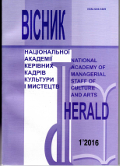МУЗИЧНИЙ НЕОКЛАСИЦИЗМ У ВИКОНАВСЬКОМУ МИСТЕЦТВІ
DOI:
https://doi.org/10.32461/2226-3209.1.2016.138479Ключові слова:
музичний неокласицизм, неокласична ситуація, об'єктивний тип виконавства,Анотація
У статті висвітлено прояви музичного неокласицизму у виконавському мистецтві та розкрито неокласичнусутність об'єктивного типу виконавства. Зроблено висновок про те, що виконавське мистецтво кінця ХІХ – ХХ століть внаслідок своєї орієнтованості на музику минулих епох неминуче реалізується у неокласичній ситуації взаємодії ідеалізованого "класичного" і актуального "сучасного" елементів, перший з яких проявляється у прагненні доточного відтворення авторського тексту, другий – в умовах його відтворення і сприйняття.
##submission.downloads##
Опубліковано
Номер
Розділ
Ліцензія
Автори, які публікуються у цьому журналі, погоджуються з наступними умовами:
1. Автори залишають за собою право на авторство своєї роботи та передають журналу право першої публікації цієї роботи на умовах ліцензії Creative Commons Attribution License International CC-BY, котра дозволяє іншим особам вільно розповсюджувати опубліковану роботу з обов'язковим посиланням на авторів оригінальної роботи та першу публікацію роботи у цьому журналі.
2. Автори мають право укладати самостійні додаткові угоди щодо неексклюзивного розповсюдження роботи у тому вигляді, в якому вона була опублікована цим журналом (наприклад, розміщувати роботу в електронному сховищі установи або публікувати у складі монографії), за умови збереження посилання на першу публікацію роботи у цьому журналі.
3.Політика журналу дозволяє і заохочує розміщення авторами в мережі Інтернет (наприклад, у сховищах установ або на особистих веб-сайтах) рукопису роботи, як до подання цього рукопису до редакції, так і під час його редакційного опрацювання, оскільки це сприяє виникненню продуктивної наукової дискусії та позитивно позначається на оперативності та динаміці цитування опублікованої роботи.

